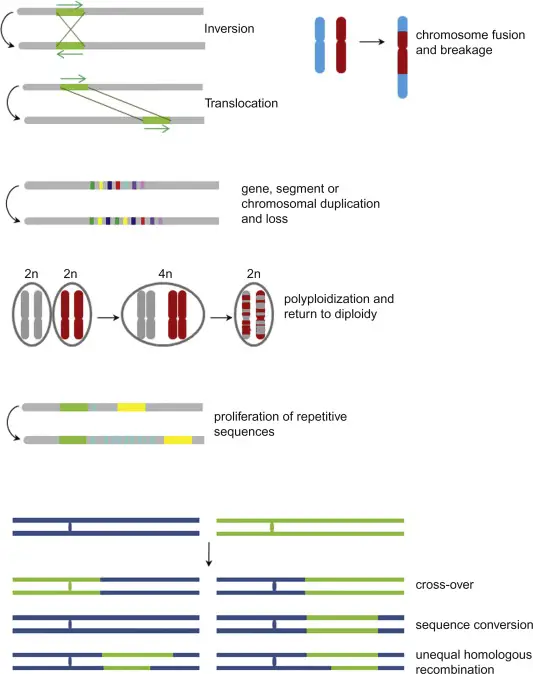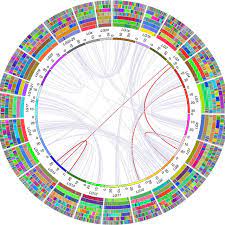Genomics is a field rife with complex terms and concepts, among which synteny and collinearity stand out due to their significance in understanding genetic architecture and evolution. Both concepts are pivotal for researchers studying the organization and function of genomes across different species, but they often come with a cloud of confusion regarding their meanings and implications.
Synteny refers to the presence of two or more genes on the same chromosome within different species, suggesting a shared ancestry and evolutionary conservation. Collinearity, on the other hand, describes a scenario where these genes are not only on the same chromosome but also maintain the same order across species. This nuanced difference plays a crucial role in the study of genome evolution and functionality.
The exploration of synteny and collinearity extends beyond mere definitions, encompassing their impact on our understanding of genetic conservation and variation. Their study provides insights into evolutionary processes, helping scientists trace the lineage of species and predict genetic functions and interactions in a broader evolutionary context.

Basic Definitions
What is Synteny?
Synteny, a term deeply rooted in genetics, refers to the condition where groups of genes are conserved on the same chromosome across different species. This genetic alignment suggests a shared lineage and provides insights into the evolutionary conservation of chromosomes. Synteny is crucial for understanding how complex genomes are organized and how they evolve over time. It serves as a foundational concept in comparative genomics, offering a way to explore the genetic relationships and evolutionary distances between species.
What is Collinearity?
Collinearity in genetics extends the concept of synteny. While synteny covers the presence of genes on the same chromosome across species, collinearity describes these genes maintaining the same sequential order. This order is preserved despite evolutionary pressures and time, indicating a highly conserved genetic structure. Collinearity is particularly significant in the study of genomic integrity and the functional mapping of genetic traits, as it highlights the ancestral links and evolutionary continuity more precisely than synteny alone.
Historical Context
Origins of Synteny
The concept of synteny emerged as scientists began to map the genomes of various organisms. Initially observed during the early 20th century through comparative cytogenetics, synteny offered a glimpse into the conserved segments of chromosomes across different species, such as humans and mice. These observations were pivotal in establishing that despite vast evolutionary divergences, certain genetic segments remained largely unchanged, underscoring the evolutionary implications of gene conservation and the shared origins of diverse life forms.
Origins of Collinearity
Collinearity was recognized as scientists refined chromosome mapping techniques and could observe not only which genes were conserved but also how their orders were maintained. Early studies in the mid-20th century, particularly involving plants, demonstrated that despite significant chromosomal rearrangements over millions of years, many plants retained a remarkable order of genetic material. This discovery was crucial for understanding how genetic information is transmitted through generations and how it remains stable despite evolutionary changes.
Key Differences
Genetic Arrangement
Comparing the structural arrangements of genomes reveals the core differences between synteny and collinearity:
- Synteny shows us that the same groups of genes can be located on the same chromosome across different species, suggesting a basic level of genetic conservation.
- Collinearity takes this observation further by demonstrating that these genes also preserve their order, highlighting a deeper level of genetic stability and conservation.
These differences are not just academic; they have practical implications in fields such as evolutionary biology, where they help clarify the lineage and evolutionary history of species.
Application in Research
Synteny and collinearity find their applications across various research domains:
- Evolutionary Biology: They are used to trace the evolutionary lineage of species, understanding how genetic material has been conserved or altered through evolutionary processes.
- Breeding Programs: In agriculture, these concepts help in identifying genetic traits that are conserved across species, aiding in the development of new crop varieties that are more resilient or productive.
Technological Implications
The study of synteny and collinearity has been greatly enhanced by advances in genomic technologies. Tools such as DNA sequencing, genomic mapping, and bioinformatics platforms allow researchers to:
- Identify and compare genetic sequences across different species more rapidly and accurately.
- Develop computational models to predict evolutionary trends and genetic conservation.

Case Studies
Synteny in Human and Mice
The comparison of human and mouse genomes provides a fascinating insight into synteny. Scientists have mapped many conserved blocks between these two species, which has greatly advanced our understanding of genetic and evolutionary mechanisms. These conserved blocks are significant for several reasons:
- Gene Conservation: Despite the evolutionary divergence between humans and mice, which separated about 75 million years ago, a large number of genes have remained unchanged in their synteny, demonstrating the fundamental biological processes conserved across mammalian evolution.
- Disease Model: Mice are often used as model organisms in medical research because these synteny blocks make them valuable for studying human diseases. By examining these conserved regions, researchers can better understand disease mechanisms and test potential treatments in a model closely resembling human physiology.
Collinearity in Plant Genomes
In the realm of agriculture, collinearity within plant genomes has profound implications for breeding and genetic studies. For instance:
- Rice and Maize: Studies have shown extensive collinearity between the genomes of rice and maize. This insight is crucial for crop improvement programs, allowing scientists to transfer knowledge and techniques between these two important crops.
- Wheat: The large, complex genome of wheat has been studied to identify collinear gene sequences shared with other grains. This knowledge aids in pinpointing genes responsible for yield and disease resistance, traits that are highly valuable to agricultural productivity.
Challenges and Limitations
Technical Challenges
The study of synteny and collinearity faces several technical obstacles:
- Complex Genomes: Many organisms have large and complex genomes that are difficult to sequence and analyze fully. This complexity can obscure synteny and collinearity patterns.
- Limited Resources: Not all species have well-mapped genomes. The lack of comprehensive genomic data for numerous organisms limits the ability to study their genetic architecture in depth.
Interpretational Variability
Interpretation of synteny and collinearity can vary dramatically between species due to several factors:
- Evolutionary Distance: The greater the evolutionary distance between the species being compared, the more challenging it is to accurately interpret synteny and collinearity due to the accumulation of mutations and chromosomal rearrangements.
- Genomic Context: The function and importance of a gene can differ by species, affecting how synteny and collinearity are understood in various biological contexts.
Future Directions
Technological Advances
The future of studying synteny and collinearity looks promising, with several technological advancements on the horizon:
- Improved Sequencing Technologies: Newer, more efficient sequencing technologies promise quicker and more accurate genome assembly, which will enhance our ability to detect synteny and collinearity.
- Advanced Computational Tools: As bioinformatics evolves, so too do the tools for analyzing and interpreting complex genomic data. These tools will provide deeper insights and more precise mappings of conserved genetic sequences.
Potential Applications
Looking ahead, the applications of understanding synteny and collinearity are vast:
- Enhanced Genetic Engineering: By leveraging knowledge of conserved gene sequences, scientists can more effectively edit genomes, introducing traits like disease resistance or drought tolerance into crops.
- Improved Disease Understanding: In medicine, understanding synteny and collinearity can lead to breakthroughs in identifying the genetic bases of diseases and developing novel therapeutic approaches.
Frequently Asked Questions
What is synteny in genetics?
In genetics, synteny refers to the arrangement of genes on the same chromosome across different species. This concept is used to identify evolutionary relationships and to study the conservation of gene order over time, providing insights into genetic stability and changes through evolutionary history.
How does collinearity differ from synteny?
While synteny involves genes being on the same chromosome in different species, collinearity goes a step further by maintaining the same order of these genes. Collinearity is a more specific term that indicates not only the shared locations but also the preservation of gene sequence among species, which is crucial for studying detailed evolutionary patterns.
Why is studying synteny and collinearity important?
Studying synteny and collinearity is crucial for understanding the evolutionary relationships between species and the functional architecture of genomes. It helps scientists predict gene function, discover genetic anomalies, and improve breeding strategies in agriculture by leveraging evolutionary conserved traits.
Can synteny and collinearity be used in medical research?
Yes, synteny and collinearity can be instrumental in medical research, particularly in identifying disease genes and understanding their evolutionary origins. By comparing gene orders and locations across species, researchers can pinpoint genetic mutations and variations linked to specific diseases, aiding in the development of targeted therapies and diagnostics.
Conclusion
The distinction between synteny and collinearity, while subtle, is fundamentally important for advancing our understanding of genomic architecture and evolutionary biology. These concepts not only illuminate the evolutionary paths of different species but also enhance our ability to interpret complex genetic information in both health and disease contexts.
By continuing to explore these patterns, researchers can unlock new insights into genetic conservation and variation, potentially leading to breakthroughs in genetic therapies, agricultural development, and a deeper understanding of our own genetic makeup. Through such studies, the intricate dance of genes across time and species continues to reveal the underlying symphony of life.

